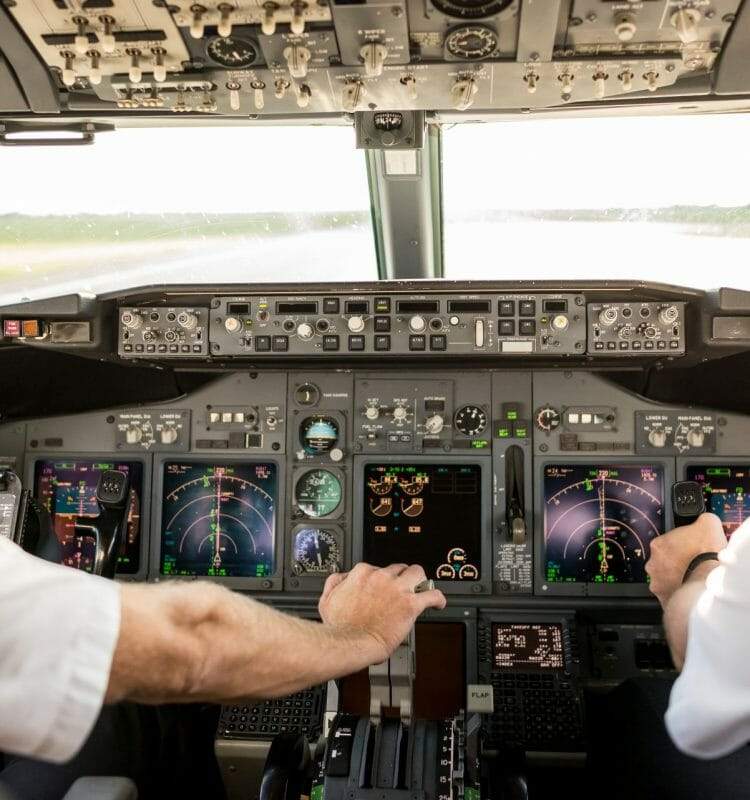EN


Hinfact’s research focuses on the very foundation of flight safety – the training of pilots. Hinfact creates and develops technologies supporting commercial aircrafts’ pilot training and training centres. Flight data, gaze direction analysis and Hinfact’s own analytics is used in the evaluation of human factors in flight situations.
Data analysis combined with technology like eye tracking is what allows Hinfact to detect critical flight situations and conduct research to improve flight safety. Thomas Bessiere, co-founder and CEO of Hinfact, describes a problem they encountered through their research:
“In critical and perhaps stressed situations pilots do not always realize that they are losing vital scan behaviors leading up to critical simulation parameters being missed. Our laboratory started working on ways to identify when and how this occurs.”
By identifying important Key Performance Indicators, Hinfact is able to help instructors detect a pilot’s strengths as well as weaknesses – and improve their assessment of pilot performance in real time. Hinfact relies on a thorough scientific background, which allows them to learn and benefit from large resources of experience and research.
“As a spin-off of the Human Factors Lab at ISAE-SUPAERO, we have direct access to 17 years of research in this field. We work every day with the scientists who are globally known as references in Human Factors in the aviation field,” says Thomas Bessiere.
The idea for a tool that would vastly improve pilot training was born when studying the flight simulators used in training centres.
“We started discussing with the instructors in the training centers and we observed that the instructor is behind the pilots in the simulator, and that they have no way of knowing where the pilots are looking and focusing their attention,” says Thomas Bessiere.
Hinfact realized that eye tracking technology is the application best suited to provide the missing feedback on pilots behaviors. On average, pilots spend 90% of their time monitoring flight parameters and the state of the aircraft. Therefore, it was crucial to find an eye tracking system that provided the technology necessary to track eye movements with the highest possible precision.
“There are several reasons why we chose Smart Eye Pro as an eye tracking solution. For one, the system is the only one offering multi-camera solutions with high precision,” explains Thomas Bessiere.
With a tool tracking the pilot’s gaze, the instructor is able to follow the pilot’s attentional focus and optimize monitoring behavior in critical training situations. This is something that would add value and efficiency to the training process and result in better prepared pilots. Not only will pilot training benefit from technology that lets instructors track the gaze of the pilot in real time, but the data can also be saved and analysed after the simulation session. Together with the instructor, the pilot can increase their awareness of monitoring behaviors they might never have noticed on their own. Higher efficiency combined with higher accuracy can be expected to reach even higher importance in the years to come.
Global demand for commercial airline pilots will likely be twice as high in just 20 years, which requires training centers to prepare for an up-coming mass-recruitment of pilots. In this scenario, eye tracking will become essential for successful recruitment and training of pilots.
“This is the reason why eye-tracking will become necessary in pilot training sessions. However, it is quite difficult for instructors to understand eye-tracking data without a Human Factors background to help them with the interpretation. This is why we created Gazecraft Training – to support instructors in the assessment of pilots’ skills and monitoring performances,” says Thomas Bessiere
Extensive research on pilot training led Hinfact to start working on The Gazecraft Analytics tool.
“We rely on our researchers’ studies to provide several metrics and visualization methods in our Analytics tool. Specific algorithms and data aggregation methods are used to display comprehensive visual patterns and to differentiate the beginners’ and experts’ scan patterns,” says Thomas Bessiere.
Thomas Bessiere also describes how Hinfact has collaborated with UX and UI designers in order to make the advanced tool easy to use for instructors.
“They just need to look at the tablet, and they have the gaze position of the pilots displayed on the screen. After the training session, they have a direct link to all important flight events and can analyze them directly in the tablet, through a static view or a dynamic one. Our main strength is that we provide eye-tracking to the instructor with a high level of post processing to give them intelligible information on monitoring performance.”
Additionally, the tool is designed for integration into different simulator platforms:
“Our goal is to provide a tool that is standardized for the whole training center. Then, because most of airlines and training centers have different types of sims, it is important to stay on top of the simulators as an add-on. We provide a full suite which has been developed to stay adaptable and generic. As of today, we can use and deploy the Gazecraft suite in all training centers where instructors need to be able to assess monitoring skills,” says Thomas Bessiere.
After years spent developing and perfecting the Gazecraft Analytics tool, the final product includes a combination of Smart Eye’s head and eye tracker technology and Hinfact’s gaze data analysis–all easily used and operated by the flight instructor alone.
Smart Eye is committed to delivering the most advanced nonintrusive 3D head and eye tracking system in the world. We are equally committed to accommodating even the most complex applications and demanding field of view requirements from a remote perspective, while still maintaining superior accuracy. Interested in eye tracking for pilot training? Contact us to learn more or to schedule a demo!
